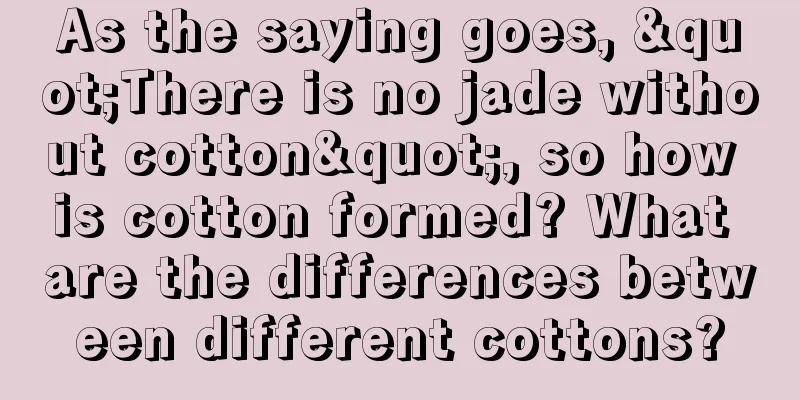As the saying goes, "There is no jade without cotton", so how is cotton formed? What are the differences between different cottons?

|
As the saying goes, "There is no jade without cotton". Cotton is the natural sign of jadeite. It is both a flaw and a feature. For example, the popular snowflake cotton, cotton, as the name suggests, It is the white cotton-like floc in jade. It often appears in the form of threads, lumps, mist, dots, etc. According to their causes, they can be divided into structural wool and mineral wool. So how is cotton formed? What are the differences between different cottons? 1. Structural cotton Structural cotton refers to the formation process of jade. Due to the different arrangement and relationship of jadeite minerals, This creates cracks or heals cracks between jadeite minerals. Under the light, it appears as clumps, blocks, strips, fog, etc. Depending on the characteristics, Structural cotton can be divided into micro-crack cotton, cotton caused by impurities and colored cotton at the microscopic level. 1. Micro crack cotton Different parts of jadeite are not exactly the same. Even within a piece of glass-type jadeite, there will be some loose structures in some areas. Where the gap is larger, Forming chaos, darkness, Depending on the shape of the structure, Produces cotton in different shapes. 2. Cotton caused by impurities Jade often contains foreign impurities. Some impurities are relatively large, while others are relatively small. Sometimes we gather together, sometimes we disperse. When they gather together, they form a mass of cotton. Like the dot-shaped cotton that is characteristic of Mu Na, when it is dispersed, Will wander in the cracks of the structure, When there are too many of them, the jade will look chaotic and dirty. This is the case with many jadeite found at the bottom of gray water. It’s just that the impurities in the cotton are also dirty. 3. Colored cotton Foreign impurities are often colored. It's not necessarily colorless. The dotted cotton in Muna is mostly colorless. It is the white cotton we commonly see. The so-called dead flowers that we often see now, It's actually colored cotton. The main performance is those with good blue flowers. Even those living flowers that look more lively, It's just that the smaller colored cotton is scattered. It looks more light, Basically, there is more cotton. 2. Mineral Wool Mineral wool is mainly the different mineral combinations produced by the crystallization differentiation of jadeite in the later stage. Especially containing albite, Due to the difference in refractive index between different minerals, and the different degrees of tightness of binding, When exposed to light, white cotton wool in the form of dots or clumps will form. Mineral wool mainly exists in the form of symbiotic or associated minerals of jadeite. It is distributed in irregular dots and clusters. It is mostly found in jadeite with fine texture. Such as ice with high transparency, It appears in oily green, blue water and black jadeite with good texture. For example, the Mu Na snowflake cotton that everyone is very familiar with. It can be seen that the presence of cotton will have an important impact on the quality of jade. First of all, cotton will affect the color of jade. The more cotton there is, the worse the light transmittance of the jadeite will be. The more it affects the color transmission; At the same time, the more cotton there is, the more concentrated it is. It will also affect the spread of color. Secondly, cotton will affect the quality of jade. That is the transparency of jadeite. Jade with a lot of cotton looks chaotic and dirty, has poor transparency, and appears a bit dull. Cotton is one of the important characteristics of jade that cannot be ignored. Correctly understand the cotton in jadeite. It is of great significance to evaluate the quality of jade and judge the authenticity of jade. Everyone should pay attention to learn more and understand more~
fcgc33 fcpf18 |
<<: Jade professional knowledge: "Jade Luster"
>>: Teach you to understand the craftsmanship of jadeite in one minute
Recommend
Afraid of being cheated when buying jade? First learn to distinguish between A, B, and C goods
First of all, B-grade and C-grade jade are relati...
How to distinguish jadeite from water foam?
There are several obvious differences between jad...
What is the meaning of jade jewelry?
In our country's traditional culture, jade is...
Jade carving, with a distinctive "geometric" style, the effect is great
Whether in the East or the West, as a traditional...
Teach you to understand these 3 rules, and you will have a clear idea when looking at jade carvings
Jade carvings are the product of oriental aesthet...
A piece of jadeite scrap with a glutinous icy green base, carved with the word "enlightenment" in it, the finished product is extremely tempting!
The best jade rough materials are moist and trans...
Jade carving craft
As the saying goes, "If jade is not carved, ...
Fashionable jade jewelry is inseparable from exquisite craftsmanship, and each inlay method is so unique
When talking about fashion, people will think of ...
The jade lucky bean is small, but it brings wealth and fortune. Choosing the right one is the key.
The exquisite shape makes the beans seem to be be...
Invite experts to deeply analyze the identification method of ABC jadeite with naked eyes
1. Look at the jadeite properties: When jadeite i...
Jade artistic conception, understanding is the charm
In the eyes of jade designers, every piece of jad...
When buying jadeite, should you look at the quality or the color? Have you made the right choice?
Most people familiar with the jade industry have ...
Recording the process of making jade bracelets, the bracelets made by Bingpiao are so beautiful!
This is a piece of ice-type jadeite with floating...
Choosing jadeite raw stones, if you don’t understand these 8 judgments, you will fail
The raw jadeite stones are all wrapped in big sto...
Buying jade, did you buy the right one? Look at the meanings of different jades. Buying jade, did you buy the right one? Look at the meanings of different jades.
There are various kinds of jade products on the m...









